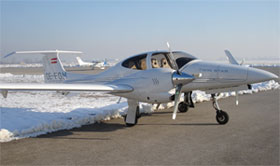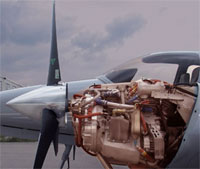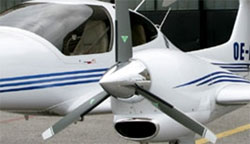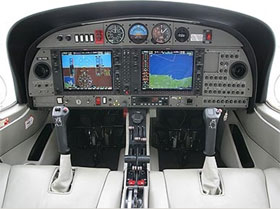 With its needle nose, wasp waist, and bulbous nacelles, the Diamond DA42 Twin Star
is among the most dramatic new entries to the general aviation market.
With its needle nose, wasp waist, and bulbous nacelles, the Diamond DA42 Twin Star
is among the most dramatic new entries to the general aviation market.
The Twin Star's airframe is basically the same as that used in Diamond's DA40 Diamond Star,
but with a nose baggage compartment and, of course, beefed-up center spar sections to support
the weight of the two engines.
The aircraft is crafted from glass and carbon fiber in a modern manufacturing process which makes the body to light weighted but still very strong. The basic empty weight of the DA42 is only 1090 kg. Using this technique also gives the benefit from generating low drag while airborne and easy to maintain and keep clean from dirt when on the ground.
The Power plants The engines that power the DA42 are essentially the same four-cylinder, 1.7-liter turbo-diesels used
in certain Mercedes-Benz automobiles. The manufacturer Thielert, has added a gearbox of his own design,
and replaced the Mercedes crankshaft and camshaft with ones of his own, and installed a customized ECU — the
heart of the Twin Star's single-lever power controls — and an electro-hydraulic autofeather system for the propellers.
The engines that power the DA42 are essentially the same four-cylinder, 1.7-liter turbo-diesels used
in certain Mercedes-Benz automobiles. The manufacturer Thielert, has added a gearbox of his own design,
and replaced the Mercedes crankshaft and camshaft with ones of his own, and installed a customized ECU — the
heart of the Twin Star's single-lever power controls — and an electro-hydraulic autofeather system for the propellers.
The engines are equipped with a redundant electronic motor management: the FADEC - system (Full Authority Digital Engine
Control) without mechanical back up. The FADEC controls and surveys the engine, and utilizes a single lever control for power
setting. In addition, the FADEC system logs all engine data for later analysis.
To deal with the extra heat put out by diesel engines, four cooling radiators are also part of the Thielert engine package:
an intercooler for the intake air heated by the turbocharger; a radiator for the glycol-based liquid engine coolant;
an oil cooler; and a heat exchanger for cabin heating.
 Diesels get their fuel economy because they always run lean. A full explanation gets complicated, but suffice it to say
that they have comparatively high compression ratios, get high-pressure fuel injection, always run at full throttle (when the
pilot moves the throttle control, this only changes the duration of the fuel-injection pulses), and therefore develop high torque
at low rpm. Unlike a spark-driven ignition system, diesels ignite their (already lean) fuel-air mixtures with the heat of
compression generated in the cylinders. It all adds up to an engine that's force-fed huge amounts of air, and that makes the
most out of a gallon of Jet-A.
Diesels get their fuel economy because they always run lean. A full explanation gets complicated, but suffice it to say
that they have comparatively high compression ratios, get high-pressure fuel injection, always run at full throttle (when the
pilot moves the throttle control, this only changes the duration of the fuel-injection pulses), and therefore develop high torque
at low rpm. Unlike a spark-driven ignition system, diesels ignite their (already lean) fuel-air mixtures with the heat of
compression generated in the cylinders. It all adds up to an engine that's force-fed huge amounts of air, and that makes the
most out of a gallon of Jet-A.
The performance of the DA 42 power plants:
T.A.E Centurion 1.7
270 hp (2x 135) total power
3 blade constant speed, full feathering
12.5 gal/tot @ 80% effect
8.8 gal/tot @ 60% effect
JetA1 Fuel
The instrumentation in the DA42 is based on the new “glass panel cockpit” concept. The heart of the system is the Garmin 1000, which is a completely integrated avionics system that presents flight instrumentation, location, navigation, communication, and identification data on large-format, high-resolution displays. The digital data presentation on the G1000 puts all flight-critical information literally at the pilot’s fingertips.
 A DA42 is equipped with all kinds of equipment, everything from standard instrumentation for basic flight operations to advanced
tools for instrument approaches and a fully integrated autopilot. It is essential to keep it simple while still having all the advanced
features at hand when needed. The navigation of the aircraft is mainly based on GPS navigation which is a system based on satellite
navigation. The GPS system receives signal from several satellites at the same time and can then by some mathematics calculate the exact
position of the aircraft, all over the world. Even if the GPS system is duplicated there is a backup system consisting of traditional
radio navigation aids based on radio stations sending out position information.
A DA42 is equipped with all kinds of equipment, everything from standard instrumentation for basic flight operations to advanced
tools for instrument approaches and a fully integrated autopilot. It is essential to keep it simple while still having all the advanced
features at hand when needed. The navigation of the aircraft is mainly based on GPS navigation which is a system based on satellite
navigation. The GPS system receives signal from several satellites at the same time and can then by some mathematics calculate the exact
position of the aircraft, all over the world. Even if the GPS system is duplicated there is a backup system consisting of traditional
radio navigation aids based on radio stations sending out position information.
Standby instruments are centered at the top of the instrument panel making them easy to view from either seat. They offer situational awareness in case of failure of the main displays. They run off their own independent powerpack which is continuously charged.
Single Lever Engine ControlsThe FADEC controlled engines takes the guesswork of powerplant management. The dual powerlevers offers jet-like thrust control and easy single engine control.
Single Lever Engine ControlsThe dual control sticks are integrated with elevator trim, autopilot disconnect and push-to-talk built in, Pushrod connections to the control surfaces makes inputs smooth and responsive.
The Panel
The left monitor is the PFD (Primary Flight Display) showing attitude, speed, heading and more information. The right monitor is the
MFD (Multi Functional Display) which shows map, terrain weather information and more. All critical flight information can be displayed
on either screen for easy viewing from either seat.
The system features dual nav/com/GPS and are powered by dual sources.